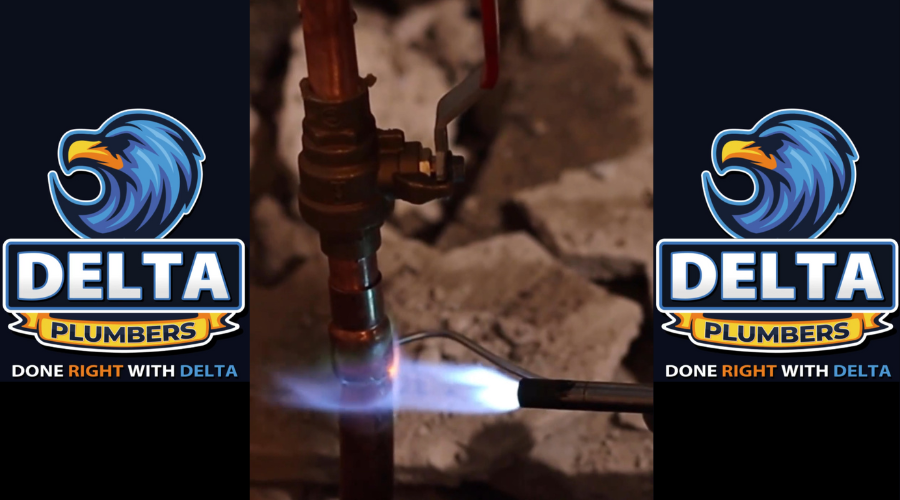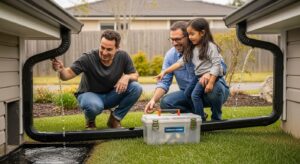Plumbing emergencies can strike at any time—whether it’s a burst pipe in the middle of the night, a clogged drain during a family gathering, or a leaking water heater threatening to flood your basement. When disaster strikes, quick action is essential to prevent costly damage and restore your home’s plumbing system. Knowing how to handle these emergency plumbing repairs can save you time, money, and stress. In this guide, we’ll walk you through common emergency plumbing issues, how to manage them, and when to call a professional plumber. Stay prepared and protect your home from unexpected plumbing disasters!

Picture Source – Delta Plumbers
Understanding Plumbing Emergencies: What Qualifies as Urgent?
Not all plumbing problems require immediate attention, but some require urgent action to prevent severe damage and costly repairs. A plumbing emergency is any situation that causes water damage, disrupts daily life, or poses a health risk. Common plumbing emergencies include:
1. Burst Pipes
Sudden pipe bursts can flood your home and cause structural damage if not addressed immediately.
2. Sewer Backups
When wastewater backs up into your home, it creates unsanitary conditions and requires professional intervention.
3. Overflowing Toilets
A toilet that won’t stop running or overflows could indicate a deeper blockage issue.
4. No Running Water
A lack of water could result from a major leak, frozen pipes, or municipal supply issues.
5. Gas Leaks (from Water Heaters)
A gas leak is a serious emergency that requires immediate evacuation and calling professionals.
6. Major Leaks
Uncontrolled water leaks can damage floors, ceilings, and walls if not contained.
Recognizing these emergencies helps you act quickly to mitigate damage before the plumber arrives.
Also Read: Detect Hidden Plumbing Leaks Before They Cause Damage

Picture Source – Delta Plumbers
Immediate Steps to Take When a Plumbing Disaster Strikes
Taking the right steps during a plumbing emergency can minimize water damage and prevent further complications. Here’s what to do:
1. Stay Calm
Panicking won’t help. Take a moment to assess the severity of the problem.
2. Shut Off Water Supply
Quickly locate and turn off the main water valve or localized shutoff valves for affected fixtures.
3. Turn Off Electricity (If Necessary)
If water is near electrical outlets or appliances, switch off the electricity to prevent shocks.
4. Contain the Water
Use buckets, towels, or a wet/dry vacuum to remove excess water and prevent further damage.
5. Identify the Source
Try to pinpoint where the problem originates to provide helpful details to your plumber.
Acting swiftly can save time and reduce repair costs when a plumbing emergency strikes.
Also Read: Spring Plumbing Issues and How to Prepare for Them

Picture Source – Delta Plumbers
How to Shut Off the Water Supply: A Step-by-Step Guide
Knowing how to turn off your home’s water supply is critical in an emergency. Follow these steps:
1. For the Whole House:
Locate the main shutoff valve, usually near the water meter or where the main line enters your home. Turn it clockwise to stop the water flow.
2. For Toilets:
Find the valve near the toilet’s base and turn it clockwise until water stops flowing.
3. For Sinks and Faucets:
Shutoff valves are typically found under the sink. Turn them clockwise to stop the water.
4. For Water Heaters:
If the heater is leaking, turn off the cold-water supply valve leading to it.
Regularly checking these valves ensures they are functional in case of an emergency.
Also Read: Water Heater Repair vs. Replacement

Picture Source – Delta Plumbers
Temporary Fixes for Common Plumbing Emergencies
While waiting for the plumber, you can take temporary measures to prevent worsening damage:
1. Leaky Pipes
Use plumber’s tape, pipe clamps, or rubber patches to slow the leak.
2. Clogged Drains
Use a plunger or a mixture of baking soda and vinegar to clear minor blockages.
3. Overflowing Toilet
Shut off the toilet’s water supply and use a plunger to remove obstructions.
4. Water Heater Leaks
Turn off the heater’s water and gas supply and avoid using hot water.
5. Frozen Pipes
Apply warm towels or a hairdryer to thaw frozen pipes gradually.
These temporary fixes can help manage the situation until professional help arrives.
Also Read: Trenchless Sewer Repair: The Future of Sewer Line Replacement Without Digging

Picture Source – Delta Plumbers
Preventing Further Damage While Waiting for a Plumber
After implementing emergency measures, take extra precautions to minimize damage:
1. Avoid Using Plumbing Fixtures
Don’t use toilets, sinks, or showers if they’re part of the problem.
2. Clear the Affected Area
Move furniture, electronics, and valuables away from the water.
3. Ventilate the Area
Open windows and use fans to dry wet surfaces and reduce humidity.
4. Use Absorbent Materials
Place towels or buckets to absorb ongoing leaks.
These steps can help limit further issues while you wait for the plumber to arrive.
Also Read: How to Prevent Basement Flooding in Ontario This Spring

Picture Source – Delta Plumbers
What to Communicate to Your Plumber for Faster Repairs
Providing your plumber with detailed information can speed up repairs. Be prepared to share:
1. The exact nature of the problem
Describe what’s happening and when it started.
2. What steps have you already taken?
Let them know if you shut off the water or tried any temporary fixes.
3. The location of shutoff valves
Useful for quick access to stop leaks.
4. Photos or Videos of the Issue
Sending visuals can help the plumber assess the situation before arrival.
A well-informed plumber can arrive with the right tools and solutions, reducing repair time.
Also Read: Spring Plumbing Maintenance Tips for Ontario Homeowners

Picture Source – Delta Plumbers
Long-Term Solutions: How to Avoid Future Plumbing Emergencies
Preventative maintenance can reduce the risk of future plumbing issues. Here’s what you can do:
1. Schedule Regular Maintenance
Annual plumbing inspections can catch minor issues before they escalate.
2. Monitor Water Pressure
High water pressure can stress pipes and lead to leaks.
3. Avoid Chemical Drain Cleaners
They can corrode pipes over time, leading to bigger problems.
4. Install Leak Detectors
Smart water sensors can alert you to leaks early, preventing major damage.
5. Insulate Pipes
Protects against freezing and bursting in cold weather.
6. Educate Household Members
Teach family members where shutoff valves are and what to do in an emergency.
Taking proactive measures can save you from costly plumbing disasters in the future.
Conclusion
Plumbing emergencies can be stressful, but knowing how to respond effectively can make a big difference. By acting quickly, shutting off the water, using temporary fixes, and preparing for the plumber’s arrival, you can minimize damage and repair costs. Keep a trusted plumber’s contact handy, and consider preventive maintenance to avoid emergencies in the first place. 🚰🔧









